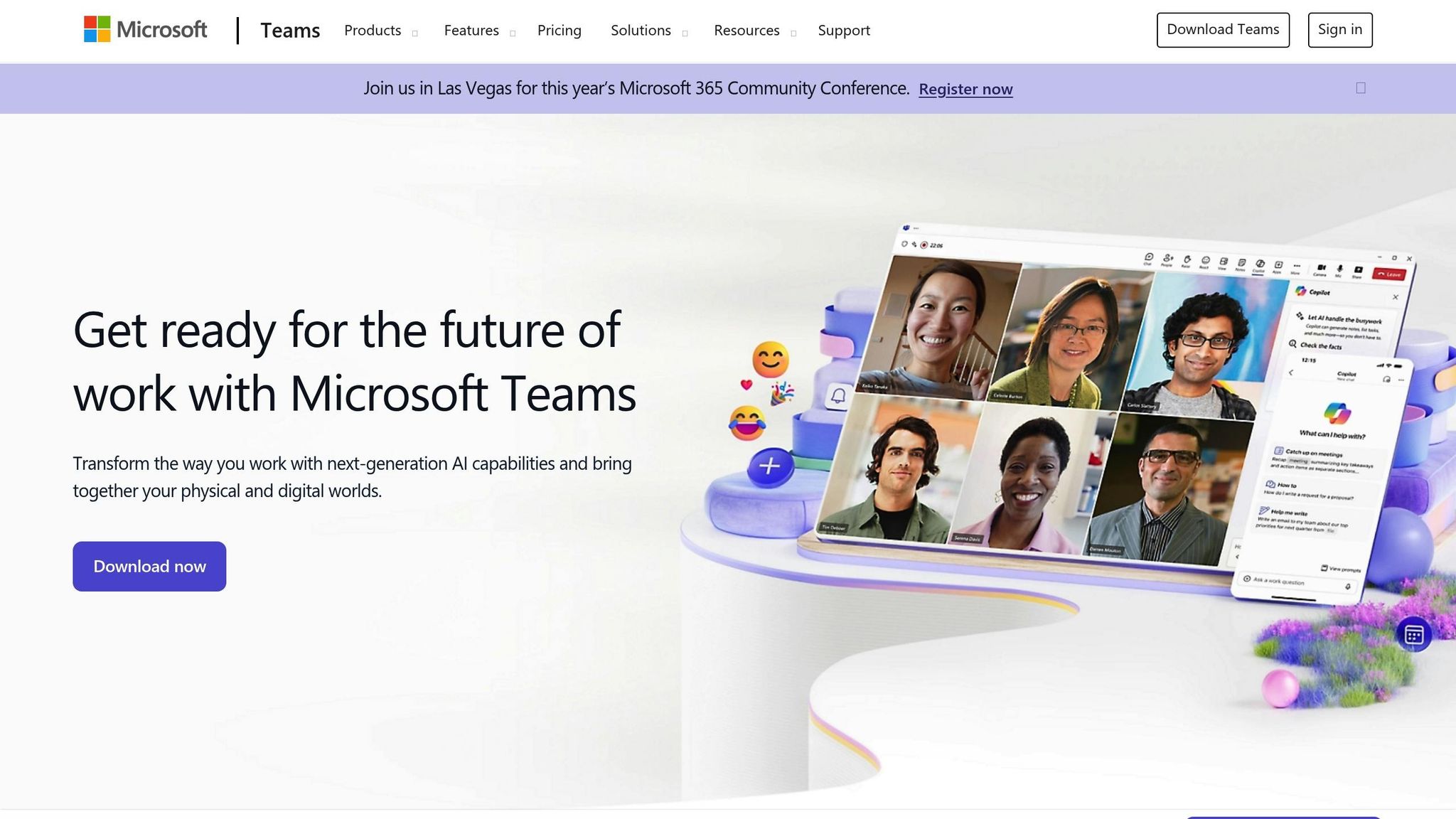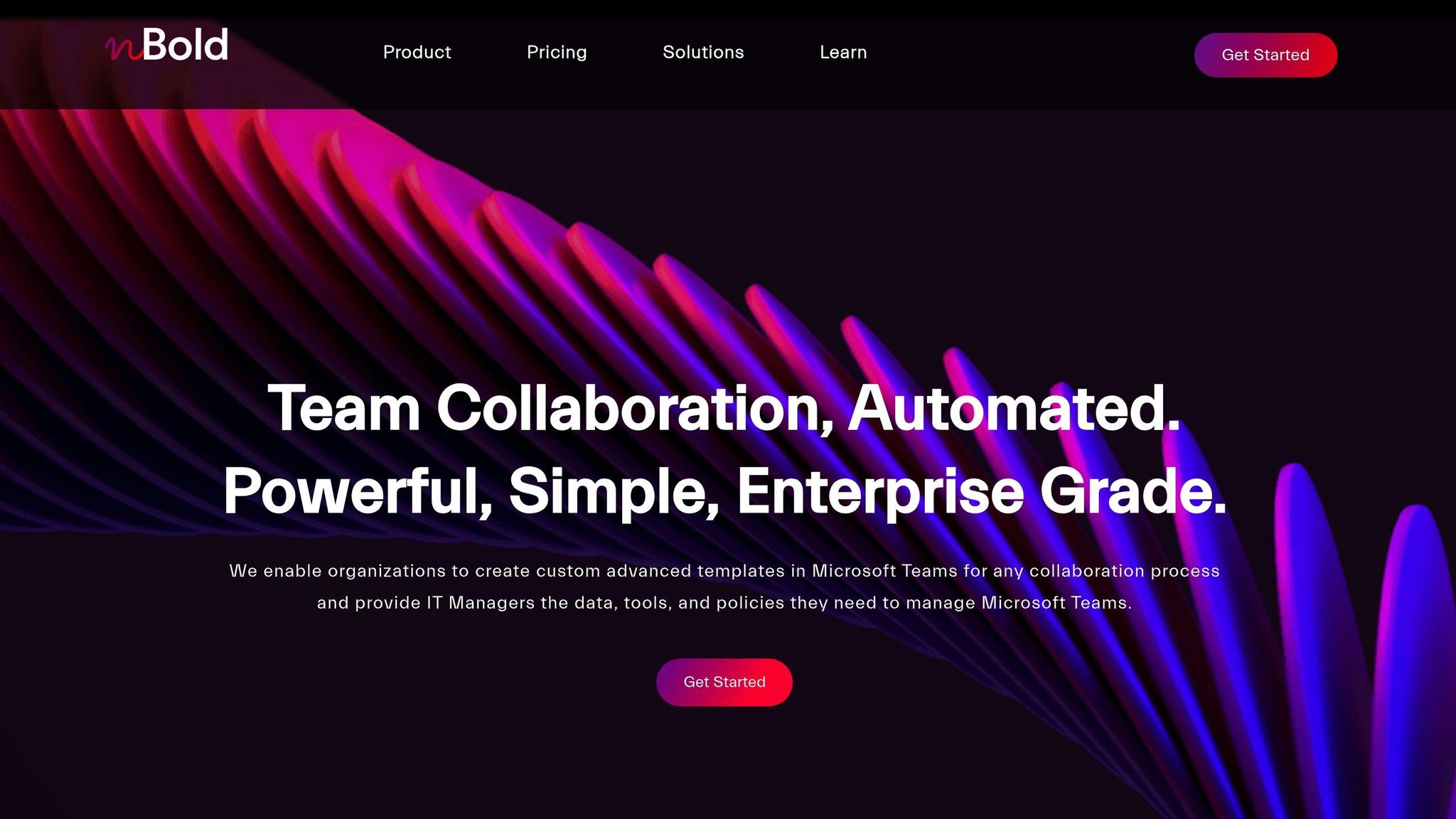Want to save time at work? Microsoft Teams and Copilot make it easy by using AI to handle repetitive tasks, summarize meetings, and streamline communication. Here’s what you need to know:
- Save Time: Automates tasks like note-taking, task tracking, and email-to-calendar scheduling.
- Meeting Insights: Summarizes discussions, highlights action items, and provides quick recaps.
- Message Assistance: Drafts and refines messages, making communication faster and clearer.
- Workflow Automation: Integrates with Power Automate to turn plain English commands into workflows.
Cost: Starts at $30/user/month, with a Pro option for $20/month.
These tools are already helping industries like healthcare and finance reduce time spent on communication and admin work. Ready to simplify your workday? Let’s dive into how it works.
Microsoft Teams and Copilot Integration

Core Functions and Capabilities
Microsoft Teams now integrates with Copilot to enhance productivity through AI. This feature allows users to easily access data from the Microsoft 365 suite – like documents, emails, presentations, and calendar invites – without needing to switch between apps.
Here’s what it can do:
- Document context awareness: Pulls key details from shared files and past conversations to deliver relevant insights.
- Intelligent task tracking: Automatically identifies and organizes tasks discussed during meetings.
- Cross-platform data access: Seamlessly connects users to information across Microsoft 365 applications.
"Microsoft 365 Copilot is revolutionizing the way we interact with Microsoft applications by introducing cutting-edge AI-driven assistance across multiple platforms." – Alexandre Cipriani
These capabilities help users save time and simplify their daily tasks.
Time-Saving Features
The Copilot integration in Teams is designed to streamline workflows and reduce time spent on repetitive tasks.
Some standout features include:
- Meeting Management: Provides live summaries, highlights action items, and logs decisions in real time.
- Workflow Automation: Handles note-taking and task management, cutting down on administrative burdens.
To make the most of Copilot, ensure your Microsoft 365 apps are updated, and configure permissions via the Admin Center. Industries like healthcare and financial services are already reporting reduced time spent on communication, data analysis, and reporting tasks.
Here are a few prompt examples to try:
- "List the main items discussed in the meeting so far."
- "Create a table of pros and cons for this campaign."
- "Did the team achieve consensus on a decision, and if so, what was it?"
Top Copilot Productivity Tips
Meeting Organization Tools
Copilot makes meetings smoother by summarizing discussions, suggesting action items, and answering questions as they come up.
- Real-time Help: Get live summaries and key points highlighted during the meeting.
- Catch-Up Mode: Running late? Ask Copilot for a quick summary to get up to speed.
- Wrap-Up Assistance: Let Copilot create clear recaps, including decisions, action items, and follow-ups.
These features also help streamline how you handle messages.
Message Management
Copilot simplifies communication by drafting concise messages and summarizing lengthy discussions. Setting clear communication guidelines can help you get the most out of these tools.
But Copilot doesn’t stop at meetings and messages – it also helps manage daily tasks.
Task Automation Steps
Copilot makes task management easier by turning emails into assignments, setting reminders, and tracking follow-ups. Here’s how it helps:
- Calendar Help: Schedule meetings directly from emails, resolve scheduling conflicts, and set up reminders.
- Workflow Tools: Automate note-taking and task creation from chats. You can even tailor Copilot’s actions to fit your specific workflow needs.
How To Use Copilot In Microsoft Teams (Step-by-Step)
sbb-itb-8be0fd2
Power Automate and Copilot Setup
Combine Power Automate with Copilot’s AI to simplify workflow automation. This integration allows you to create workflows using natural language commands, making automation easier than ever.
Creating Flows with AI
Copilot in Power Automate turns plain English prompts into workflows. Use a straightforward "When X happens, do Y" format to define your automation.
Here’s how to set up a flow:
- Start with a Clear Prompt
Describe your scenario in plain English. For example: "When an email arrives from a specific sender, post the message in Teams." - Review and Adjust
After Copilot generates the flow, review the settings and connections it has configured. Make sure everything aligns with your needs. - Test and Activate
Test the flow to ensure it works as expected. Make any necessary tweaks before deploying it.
These steps will help you create workflows efficiently.
Common Automation Examples
Here are some practical ways to use Teams and Copilot together:
| Automation Type | Description | Benefit |
|---|---|---|
| Email Processing | Post summaries of emails from specific domains to Teams | Saves time on manual tasks |
| SharePoint Integration | Notify team members when new items are added | Keeps everyone updated |
| Mobile Notifications | Send custom alerts based on Teams activities | Ensures quick responses |
Tips for Better Results:
- Be specific about connectors (like Outlook or Teams) in your prompts.
- Double-check Copilot’s configurations before saving your flow.
- Use the flow designer for small adjustments.
Copilot works best with English prompts. If you don’t see the Copilot option, ask your admin to verify it’s enabled in your Power Platform environment.
Integrate these flows into your Teams processes to save time and improve communication.
Business Applications of Copilot
Building on Teams’ integration and productivity tips, let’s dive into how Copilot simplifies business processes and improves efficiency.
Microsoft Teams and Copilot work together to enhance daily operations. These tools help organizations save time by automating repetitive tasks and streamlining workflows.
Automating Team Setup
Use nBold templates with Copilot to standardize how teams are created and organized. This duo ensures consistency across your company by automating tasks like:
- Channel Setup: Pre-create standard channels based on your template.
- File Organization: Automatically establish folder structures and file templates.
- App Integration: Connect third-party tools without manual steps.
You can also embed compliance rules directly into your templates. The template builder allows you to design workflows that Copilot can execute hands-free.
Smarter Meeting Management
Copilot’s Intelligent Recap feature reviews transcripts and chats to deliver detailed meeting insights. Key features include:
- Summaries Made Easy: Automatically create detailed meeting summaries by combining transcript and chat data.
- Task Tracking: Identify and assign action items discussed during meetings without extra effort.
Analyzing Workflows
Copilot’s AI can evaluate workflows, pinpoint bottlenecks, and recommend adjustments to improve efficiency. Here’s how it helps:
- Better Communication: Use Copilot’s enhanced chat tools to draft clear, consistent messages.
- Task Prioritization: Let Copilot review workflow patterns and suggest which tasks to tackle first.
- Process Refinement: Apply AI-driven insights to improve existing processes and automate routine work.
Copilot and nBold Best Practices

To get the most out of Copilot and nBold, focus on refining team setups and optimizing workflows. Here’s how you can make these tools work better for you.
Setting Up AI Commands for Better Workflows
Tailor Copilot commands to fit your team’s regular tasks. Start by identifying the tasks you handle most often. Then, create commands using clear and specific language. Add context, define the desired outcome, and keep the scope manageable.
For example, if you need a meeting summary, you could instruct Copilot to focus on key decisions, action items, and deadlines from the transcript.
Using nBold Templates for Smoother Processes
Standardize your workflows with nBold templates. Set up channels, organize files, integrate essential apps, and establish permission levels. A project kickoff template, for instance, could include pre-defined channels, document templates, automated task triggers, and links to project management tools.
Configuring AI Assistants for Better Results
Fine-tune Copilot to align with your team’s needs. Train it to understand your company’s terminology, set default communication styles, and establish workflow triggers.
For scheduling meetings, you can set preferences for meeting durations, buffer times, participant rules, and time zone adjustments. This ensures smoother coordination across teams.
Wrapping Up
Microsoft Teams, Copilot, and nBold work together to create a powerful ecosystem for improving teamwork. By combining AI-driven automation with ready-to-use templates, businesses can cut down on repetitive tasks and make collaboration more efficient.
Here’s how you can get started:
- Use basic Copilot commands for tasks like summarizing meetings or drafting messages.
- Gradually expand to more advanced workflows using Power Automate.
- Apply nBold templates to simplify team setup and manage channels consistently.
Start small by customizing commands and testing workflows. Refine them over time as your team gets comfortable. The goal is to focus on solutions that directly solve your business challenges while keeping things straightforward.
Take advantage of AI tools today to boost efficiency and stay ahead of the competition.
